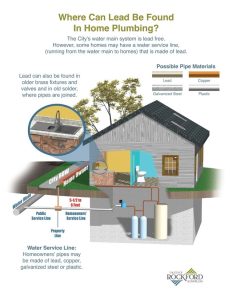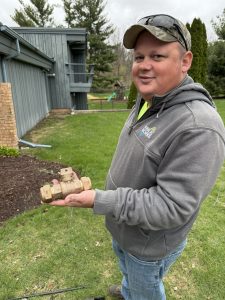What to know about lead service line replacements
By Lynne Conner For Chronicle Media — May 23, 2025 Though public works and road construction projects present a seasonal nuisance, improving the city’s infrastructure benefits the entire community.
Though public works and road construction projects present a seasonal nuisance, improving the city’s infrastructure benefits the entire community.
This is especially true for Rockford’s ongoing lead water service line replacement program.
According to Jamie Rott, water superintendent for Rockford, there is essentially no lead in Rockford’s source water, which comes from deep underground aquifers.
Lead is only introduced into the city’s water supply through service lines.
“Water service lines in the city of Rockford have two categories,” Rott said, “Public side lines are maintained by the water division and extend from city streets to residential property boundaries. Private side water lines are the homeowners’ responsibility and extend from the property line into the residence.”

Jamie Rott
“In older areas of Rockford — like downtown and along the Rock River — some public side water lines are made of lead. However, from late 1959 to the present, the water division stopped using lead for public side water lines and switched to copper,” she said. “It wasn’t until the late 1970s that lead was (also) prohibited from use in private side water lines.”
“In children, low levels of lead exposure have been linked to damage to the central and peripheral nervous system, learning disabilities, shorter stature and impaired formation and function of blood cells,” according to a U.S. Environmental Protection Agency summary.
The goal of Rockford’s line replacement program is to remove all existing public and private side lead lines, unknown material lines and galvanized metal lines and replace them with copper.
The scope and sequence of the project are daunting, but Rott said the water division
has an action plan.
“Since 2017, the city accelerated its efforts to address lead service lines by offering residents zero-interest loans on their water bills if they agreed to private side water line replacement,” she said. “Homeowner participation in this process was quite low.”
“In 2019, the water division received $2 million of funding through the Illinois State Revolving Loan Fund program to replace public and private side lead pipes with copper. We wanted to make the lead service line replacement program free to our customers.”
Matt Moorman, water division project manager, said homes connected to city water with private side lead pipes are eligible for a one-time service line replacement and warranty.

Mat Moorman
“In August, the Illinois Environmental Protection Agency required the water division to inventory every service line in our system,” he said. “Homeowners received a letter with a QR code and instructions to self-report the material of their private side water lines.
The customer reports provided the water division with an inventory of private side lines made of lead, unknown metals or galvanized metal requiring replacement.”
“Of the 45,000 letters sent, we only received around 2,000 self-reported responses,” Moorman said. “The water division put this information into a color-coded interactive city map.
If a residence has private side lead pipes, that address is noted with a red dot, copper pipes are noted with a green dot, galvanized pipes requiring replacement are noted with an orange dot and unknown material pipes feature a blue dot.”
Moorman said that 3,500 lead service lines have been replaced since 2017.
While the water division maintains records of materials used in public side water lines, receiving customer-reported information on private side water lines is a significant asset in the lead service line replacement process.
“At this time, Rockford’s water division has decided to replace private side lead lines at no cost to our customers. We are actively seeking funding from grants and loans, not taxpayer dollars, to finance the replacement project,” Rott said.
“About two years ago, the IEPA ruled that our water division would have 30 years to complete the replacement project based on the lead service lines we have,” she said. “Last October, the federal government mandated that starting in 2027, cities would have 10 years to complete lead line replacement.”
Funding, manpower and equipment costs all factor into how soon residents may see their lead lines replaced.
“We will need between $400 million and $600 million to replace Rockford’s 30,000 lead service lines within the 10-year timeline,” Rott said.
“Our priority is to maximize funding and replace lead service lines in older areas of the city, especially around schools and day care centers,” she said.
“Currently, we are replacing approximately 500 lead service lines per year, but the water division will need to increase that number to 3,000 by 2027 per the new regulations,” Moorman added.
“We will continue actively seeking funds through loans and grants at the state and federal levels. This will keep lead service line replacements free for as long as possible. Nevertheless, there is a possibility that an increase in water rates may be necessary to fund
the replacement project,” Rott said.
Though a quick fix to lead line service replacement may be somewhat elusive, Rott said there are several things water division customers can do to minimize lead in their water lines.
“Lead is more of an issue when pipes sit stagnant for long periods,” she said. “Running your water tap for several minutes after a vacation clears lead from the lines, as does flushing your water lines every morning before bathing or drinking water.”
“Cleaning out faucet aerators and getting a lead test kit from the water division are proactive ways to combat lead in water lines,” she said. “Visiting the city of Rockford water division home page at www.rockfordil.gov/190/Water-Division provides consumer information and access to the QR code for testing private side water lines.”
“The water division’s priority is furnishing our residents with safe, clean water and ensuring the lead line replacement project moves along as quickly and seamlessly as possible,” Rott said. “We appreciate customer input and are dedicated to engaging with the public throughout this ongoing process.”






